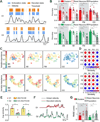Spatially Compact Neural Clusters in the Dorsal Striatum Encode Locomotion Relevant Information
- PMID: 27667003
- PMCID: PMC5087607
- DOI: 10.1016/j.neuron.2016.08.037
Spatially Compact Neural Clusters in the Dorsal Striatum Encode Locomotion Relevant Information
Abstract
An influential striatal model postulates that neural activities in the striatal direct and indirect pathways promote and inhibit movement, respectively. Normal behavior requires coordinated activity in the direct pathway to facilitate intended locomotion and indirect pathway to inhibit unwanted locomotion. In this striatal model, neuronal population activity is assumed to encode locomotion relevant information. Here, we propose a novel encoding mechanism for the dorsal striatum. We identified spatially compact neural clusters in both the direct and indirect pathways. Detailed characterization revealed similar cluster organization between the direct and indirect pathways, and cluster activities from both pathways were correlated with mouse locomotion velocities. Using machine-learning algorithms, cluster activities could be used to decode locomotion relevant behavioral states and locomotion velocity. We propose that neural clusters in the dorsal striatum encode locomotion relevant information and that coordinated activities of direct and indirect pathway neural clusters are required for normal striatal controlled behavior. VIDEO ABSTRACT.
Published by Elsevier Inc.
Conflict of interest statement
Author Information EC is a co-founder of TeraDeep Inc, Financial Conflicts of Interest are managed by Purdue University’s Conflict of Interest Committee. All other authors declare no competing financial interests.
Figures




References
-
- Albin RL, Young AB, Penney JB. The functional anatomy of basal ganglia disorders. Trends in neurosciences. 1989;12:366–375. - PubMed
-
- Alexander GE, Crutcher MD. Functional architecture of basal ganglia circuits: neural substrates of parallel processing. Trends in neurosciences. 1990;13:266–271. - PubMed
MeSH terms
Substances
Grants and funding
LinkOut - more resources
Full Text Sources
Other Literature Sources
Molecular Biology Databases

